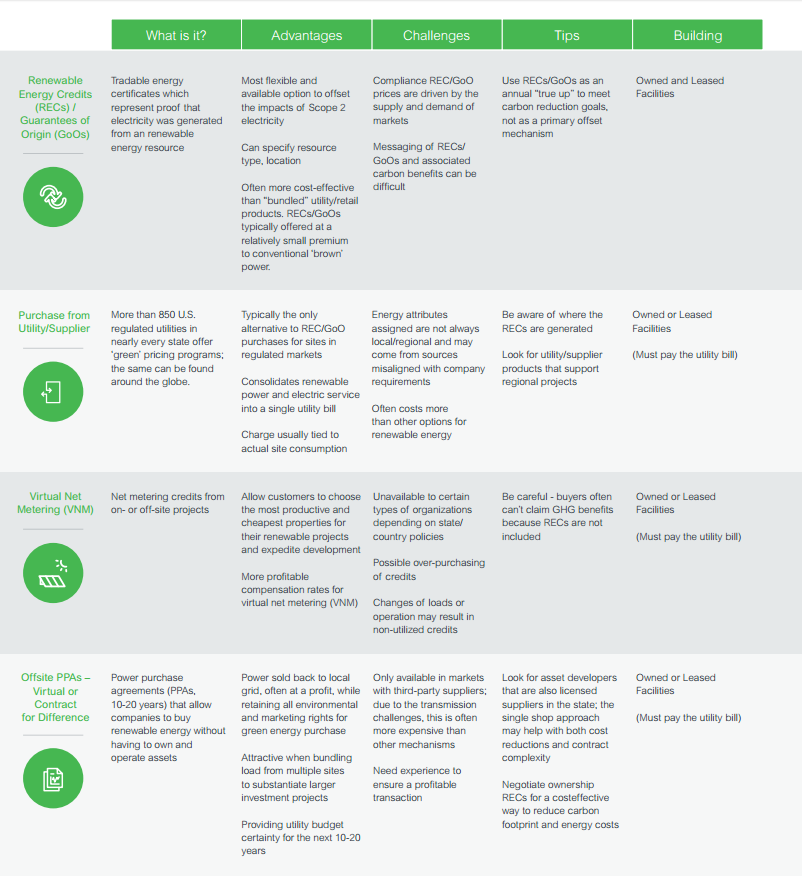This audio was created using Microsoft Azure Speech Services
Choosing the right renewable energy option requires a deep and detailed understanding of current energy spending and usage patterns, budget goals, and risk tolerance. These variables will dictate many of the factors that go into planning and executing an effective renewable energy program. And it’s not always a one-size-fits-all strategy; it may make sense to employ multiple approaches depending on geography.
Each region has its own particular incentives and financial opportunities. Solar, wind, storage or other distributed energy resources may make sense for an organization depending on regional incentives, available technology and the local environment.
Here’s a closer look at three of the more prominent strategies:
Owned Onsite Generation: This strategy allows companies to own the renewable energy systems and assets outright. This approach can be attractive to companies that have allocated budgets — and physical space for renewable generation — since these systems can outlast the economic life of a 15- to 20-year power purchase agreement (PPA, more below). However, when choosing onsite generation, owners are responsible for the operation and maintenance of the system, regardless of its performance.
Owners also can be exposed to issues like the price volatility of generated attributes and delays in reimbursement from grant programs. Other risks include interconnection delays and lost production while waiting for approval from the utility to install the system. The good news: many of these risks can be mitigated either through selling long-term contracts or requiring a production guarantee from the installer, according to a report from the National Renewable Energy Laboratory.
Utility or Supplier Purchased: An ever-increasing number of utilities and suppliers offer some type of ‘green’ energy pricing or accredited tariffs, often at a premium over traditional brown energy. Purchasing from a utility or supplier can be one of the most simple, short-term renewable energy strategies, however, it’s not always the most cost-effective, sustainable solution.
It’s important to note that this strategy doesn’t always guarantee that renewable sources are local, which may not fit with a corporation’s sustainability goals. Pricing can be higher than other options due to high program-management costs or grid operator regulations. Companies that choose this option should be aware of where the attributes such as renewable energy credits (RECs) and guarantees of origin (GoOs) are generated. The good news: organized initiatives, such as the Corporate Renewable Energy Buyers’ Principles in the U.S., are starting to appear, and provide help and advice on the increasing market demand for utility provided, cost-competitive green energy.
Power Purchase Agreements: PPAs are long-term (typically 10- to 20-year) agreements to buy power from renewable energy assets. A third-party financier provides the capital to build, operate and maintain the renewable energy source for a set period, located either onsite at a company’s facility or offsite. Companies are only responsible for purchasing the electricity the system produces, while the PPA provider assumes all risks and responsibilities of ownership.
And the electricity that’s purchased doesn’t have to be consumed by the company that signs the agreement. The energy can offset the use of brown power. (This is known as a virtual PPA, more below.) As such, PPAs can even work for organizations that don’t own their own buildings, or have a footprint where a wind or solar farm is located.
PPAs have enabled corporations to enter the market in full force. In 2015, approximately 75 percent of the megawatts (MWs) contracted through PPAs during the fourth quarter were from corporate purchases. For the first time ever in America, non-utility buyers emerged as the leader over utility buyers when it comes to new wind farms.
In PwC’s Corporate Renewable Energy Procurement Survey, 80 percent of companies surveyed are planning to build out their renewables portfolio. And of this 80 percent, the majority plan to do so using multiple types of transactions — e.g., a mix of offsite and onsite PPAs. Just last year, corporations signed 3.44 gigawatts (GW) of PPAs, nearly a 300 percent increase from 2014.
However, the total price of procuring through PPAs can be higher than owned renewable projects, especially if contracts expire before the technology reaches the end of its life. At that point, companies need to either buy the system or re-sign a new agreement.
To address these issues, developers are attempting to lower capital costs through innovative financing methods such as project portfolio securities. For example, a commercial developer in the U.S. recently raised funds from three securitizations at coupon rates of 4.0 to 4.8 percent, backed by cash flows from pools of its distributed systems. The capital secured with this action could fund future systems, which means more PPA options will be available to organizations like retailers that may not own buildings. With this practice pioneering in the U.S., it will be still some time before it will spread to other markets.
When it comes to offsite PPAs, there are two models for energy and sustainability managers to consider:
a. Physical PPAs: These agreements are somewhat similar to a conventional electricity contract, but with several notable differences. The most significant change is that instead of being in the dark about how and where energy is generated, organizations contract to buy electricity from a specific offsite renewable source, and then deliver that power to one or more of their real estate assets. Additionally, physical PPAs require a 10- to 20-year commitment, much longer than a traditional purchase of energy. Finally, due to wind and solar’s inherent intermittency, these agreements are often supplemented with scheduling and balancing services that ensure all energy requirements are met.
b. Virtual PPAs: Also known as a “synthetic PPA” or shortened to V-PPA, this is an entirely financial mechanism that allows corporations to drive offsite development of renewable power generation through a long-term fixed agreement. Buyers can significantly reduce scope 2 greenhouse gas (GHG) emissions — which standardizes how corporations measure emissions from purchased or acquired energy — encourage the development of new renewable generation, and realize the financial benefits of green energy without managing the complexity of transmission, scheduling and balancing.
For a broader view of the opportunities to access renewable energy, the following table outlines all the established strategies available to companies, and examines the advantages and challenges of each.
To learn more about the “why” and “how” behind renewable energy buying, download our Renewable Energy Strategies for Every Company whitepaper.
Check out this website for additional insights as well.





Conversation
Peter Chalmers
8 years ago
Some great information here for us to consume. We are focused on residential solar panel installation at the moment but some good insight here for us to consume, thank you.